Sources
- Art de Catalunya, Pintura antiga i medieval. Vol. 8. Barcelona: Educuons L'isard. 1998. ISBN 84-89931-06-2.
Arnau Bassa was a Catalan painter of the 14th century.
He was the son and disciple of painter Ferrer Bassa, with whom he collaborated on numerous works. He introduced the style influences of the pre-Avignonese school, but later he moved to a more Italianized Gothic painting, of which he became one of the main exponents in Catalonia, Spain.
Among his works is an altarpiece for the shoemakers guild of Barcelona (11 December 1346), destined to the city's cathedral, later moved to the Basilica of Santa Maria in Manresa. In 1347, together with his father, he executed the retablo of St. James for the Monastery of Jonqueres, now in the Diocesan Museum of Barcelona. He also took part in the retablo of the Royal Palace of La Almudaina in Palma de Mallorca (now in the National Museum of Ancient Art in Lisbon), which was later finished by the workshop of Ramón Destorrents, after both Arnau and Ferrer had died of plague in 1348.

Miquel Barceló Artigues is a Spanish painter.

The Museu Nacional d'Art de Catalunya, abbreviated as MNAC, is a museum of Catalan visual art located in Barcelona, Catalonia, Spain. Situated on Montjuïc hill at the end of Avinguda de la Reina Maria Cristina, near Pl Espanya, the museum is especially notable for its outstanding collection of romanesque church paintings, and for Catalan art and design from the late 19th and early 20th centuries, including modernisme and noucentisme. The museum is housed in the Palau Nacional, a huge, Italian-style building dating to 1929. The Palau Nacional, which has housed the Museu d'Art de Catalunya since 1934, was declared a national museum in 1990 under the Museums Law passed by the Catalan Government. That same year, a thorough renovation process was launched to refurbish the site, based on plans drawn up by the architects Gae Aulenti and Enric Steegmann, who were later joined in the undertaking by Josep Benedito. The Oval Hall was reopened for the 1992 Summer Olympic Games, and the various collections were installed and opened over the period from 1995 to 2004. The Museu Nacional d'Art de Catalunya was officially inaugurated on 16 December 2004. It is one of the largest museums in Spain.

Roberto Montenegro Nervo was a painter, muralist and illustrator, who was one of the first to be involved in the Mexican muralism movement after the Mexican Revolution. His most important mural work was done at the former San Pedro and San Pablo monastery but as his work did not have the same drama as other muralists, such as Diego Rivera, he lost prominence in this endeavor. Most of his career is dedicated to illustration and publishing, portrait painting and the promotion of Mexican handcrafts and folk art.

Lluís Borrassà was a Catalan painter. He was employed by the Crown of Aragon and is widely considered to have introduced the International Gothic painting style into the Principality of Catalonia.
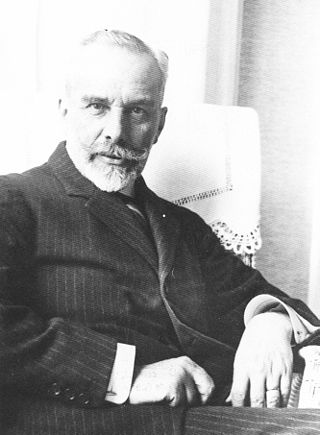
Enric Sagnier i Villavecchia was a Spanish architect.

Friar Juan Bautista Maíno, or Mayno was a Spanish Baroque painter.

Fernando Gallego was a Castillan painter, and his art is generally regarded as Hispano-Flemish in style. Gallego was likely born in Salamanca, Spain, and worked throughout Castile and Extremadura, most notably in Ciudad Rodrigo, Plasencia, Toro, and Zamora.
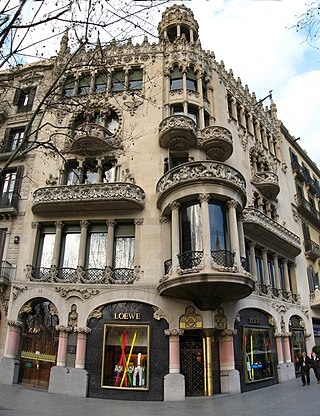
The Casa Lleó Morera is a building designed by noted modernisme architect Lluís Domènech i Montaner, located at Passeig de Gràcia 35 in the Eixample district of Barcelona. In 1902 Francesca Morera assigned Lluís Domènech i Montaner to remodel ancient "casa Rocamora", built in 1864. She died in 1904, and the building was named after her son, Albert Lleó i Morera. The building is located on the corner of Carrer del Consell de Cent, and is one of the three important buildings of Barcelona's Illa de la Discòrdia, and it is the only building of the block awarded Barcelona's town council's Arts Building Annual Award, obtained in 1906. The building lost some of its most representative elements, such as the tempietto on its top and the ground floor and mezzanine's architectural sculpture. The building is also known as the residence of Cuban-Catalan photographer Pau Audouard.
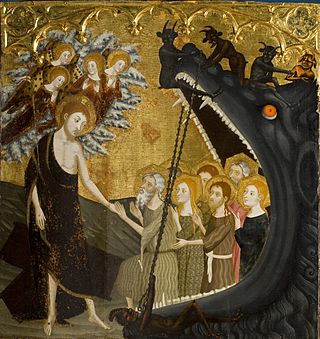
Jaume Serra was a Catalan painter. Serra was influenced heavily by a Sienese style introduced by Ferrer Bassa.

Jaume Huguet was a Catalan painter.
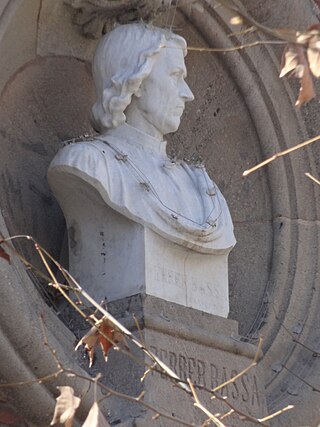
Ferrer Bassa was a Catalan Gothic painter and miniaturist.

The Monastery of Pedralbes is a Gothic monastery in Barcelona, Catalonia, Spain. It is now a museum, housing permanent exhibitions on its own art and legacy as well as third-party special exhibitions from time to time. The Chapel of St. Michael was restored and re-opened in 2018.

The Collegiate Basilica of Santa Maria, also known as La Seu, is a Romanesque-Gothic church in Manresa, Catalonia, north of Spain.

Ramón Destorrents was a Catalan mid-14th century painter and miniaturist. He was influenced by the Sienese Gothic painting.

Gonzalo Pérez, or Gonçal Peris Sarrià, was a Valencian painter of the first half of the 15th century. His life is scarcely documented. He executed altarpieces and devotional paintings in his hometown, Valencia, in the late Gothic style from 1380 and 1451. Also, he worked for altarpiece in Cuenca, Murcia, Ródenas, Burgo de Osma or Puertomingalvo.

Joaquin Mir Trinxet or Joaquin Mir y Trinxet was a Catalan artist known for his use of color in his paintings. He lived through a turbulent time in the history of his native Barcelona. His paintings helped to define the Catalan art movement known as modernisme.
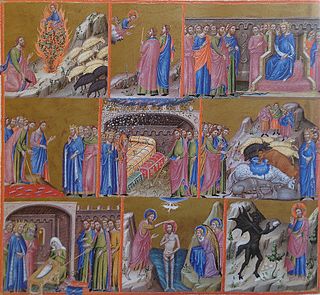
The Great Canterbury Psalter is an early 13th- and mid 14th-century illuminated manuscript with the shelfmark MS lat. 8846 in the Bibliothèque nationale de France in Paris. It was made in two different locations and moments in time: at Canterbury around 1200 and in Catalonia around 1340. It is the last of a series of copies of the Utrecht Psalter made in Canterbury, following the Harley Psalter and the Eadwine Psalter.

Pablo Gabino Rey Sendón is a Spanish painter artist born in Barcelona in 1968.

Public art in Barcelona is a designated group of monuments and outdoor sculptures in the city. The artworks in city's architecture and network of museums, parks, and gardens, put an artistic stamp on the Catalan capital. Public art in the city developed in the 19th century, although the first municipal commission was the 1673 monument to Saint Eulalia in Pedró Square.
Arnau Alemany was a Catalan painter. His style is magical realism or surrealism. He studied at Conservatori d’arts sumptuàries and later he graduated in Massana Art School in Barcelona. His influences are: René Magritte, Balthus and Pierre Roy. In 1991 he won the Biennal d’Art of Montecarlo second prize. His first exhibitions were in Catalonia and later he presented his paintings in València, London, Paris, Lyon, Madrid, Napa Valley-CA, New York, Miami, Los Angeles, Chicago, Japan. His original works are painted in oil on panel painting, though he has also produced an extensive collection of hand-signed and numbered lithographs. He painted social buildings from Paris, Barcelona or New York in desert landscapes and desolate abandonment, ghost towns, industrialised cities, where nature consumes the streets and buildings.